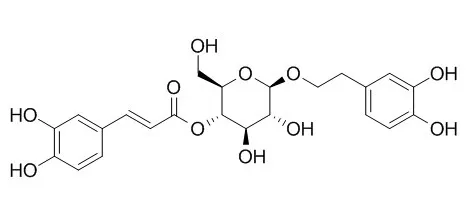| Description: |
Calceolarioside A shows potent activity against visceral leishmaniasis. It can induce a dose-related aggregant effect on rabbit platelets, which may be partly related to a calcium-dependent mechanism. Calceolarioside A also has potent antioxidative activity, it displays stronger scavenging potential with IC50 values of (4.15 +/- 0.07, 40.32 +/- 0.09, 2.26 +/- 0.03 microM) for OH, total ROS and scavenging of ONOO(-), respectively. |
| Targets: |
Calcium Channel | Antifection |
| In vitro: |
| Planta Med. 1993 Aug;59(4):337-9. | | Platelet aggregation induced by calceolarioside A in vitro: role of platelet intracellular calcium.[Pubmed: 8372152] | The effect of Calceolarioside A, a phenylpropanoid glycoside (PhG), isolated from Calceolaria hypericina, was studied on rabbit platelets in vitro.
METHODS AND RESULTS:
Calceolarioside A induced a dose-related aggregant effect on rabbit platelets. Indomethacin did not modify the Calceolarioside A-induced aggregant effect. Furthermore, no modification was exerted by phenoxybenzamine, BW 577C, and WEB 2086 on the PhG aggregant effect. On the contrary, TMB-8, an intracellular calcium blocker, significantly reduced the PhG effect.
CONCLUSIONS:
The latter result suggests that Calceolarioside A aggregation may be partly related to a calcium-dependent mechanism. | | J Enzyme Inhib Med Chem. 2009 Aug;24(4):993-7. | | Antioxidant phenylpropanoid glycosides from Buddleja davidii.[Pubmed: 19548780] |
METHODS AND RESULTS:
Phytochemical investigations on the n-BuOH-soluble fraction of the whole plant of Buddleja davidii led to the isolation of the phenylpropanoid glycosides 1-10. Their structures were determined by 1D and 2D NMR spectroscopic techniques. All the compounds showed potent antioxidative activity in three different tests, with IC(50) values in the range 4.15-9.47 microM in the hydroxyl radical ( OH) inhibitory activity test, 40.32-81.15 microM in the total ROS (reactive oxygen species) inhibitory activity test, and 2.26-7.79 microM in the peroxynitrite (ONOO(-)) scavenging activity test.
CONCLUSIONS:
Calceolarioside A (1) displayed the strongest scavenging potential with IC(50) values of (4.15 +/- 0.07, 40.32 +/- 0.09, 2.26 +/- 0.03 microM) for OH, total ROS and scavenging of ONOO(-), respectively. |
|
| In vivo: |
| Planta Med. 2008 Apr;74(5):503-8. | | In vivo efficacy of calceolarioside A against experimental visceral leishmaniasis.[Pubmed: 18543147] |
METHODS AND RESULTS:
Bioactivity-guided fractionation has led to the successful isolation of Calceolarioside A ( 1) from the methanolic extract of night jasmine leaves. The in vitro antileishmanial activity of Calceolarioside A was determined (IC (50) = 20 microg/mL). Its IN VIVO efficacy was noted at 20 mg/kg body weight when it reduced the hepatic and splenic parasite burden by 79 and 84 %, respectively, in an established model of L. donovani Ag83 infected golden hamster. Furthermore, synergistic potentiations of Calceolarioside A at 20 mg/kg body weight and SAG at 5 mg/kg body weight showed a significant reduction of hepatic and splenic parasite burden. No cytotoxicity was observed against the U937 cell line.
CONCLUSIONS:
This is the first report describing the isolation of Calceolarioside A from N. arbor-tristis L. and the first demonstration of its potent activity against visceral leishmaniasis. |
|






 Cell. 2018 Jan 11;172(1-2):249-261.e12. doi: 10.1016/j.cell.2017.12.019.IF=36.216(2019)
Cell. 2018 Jan 11;172(1-2):249-261.e12. doi: 10.1016/j.cell.2017.12.019.IF=36.216(2019) Cell Metab. 2020 Mar 3;31(3):534-548.e5. doi: 10.1016/j.cmet.2020.01.002.IF=22.415(2019)
Cell Metab. 2020 Mar 3;31(3):534-548.e5. doi: 10.1016/j.cmet.2020.01.002.IF=22.415(2019) Mol Cell. 2017 Nov 16;68(4):673-685.e6. doi: 10.1016/j.molcel.2017.10.022.IF=14.548(2019)
Mol Cell. 2017 Nov 16;68(4):673-685.e6. doi: 10.1016/j.molcel.2017.10.022.IF=14.548(2019)